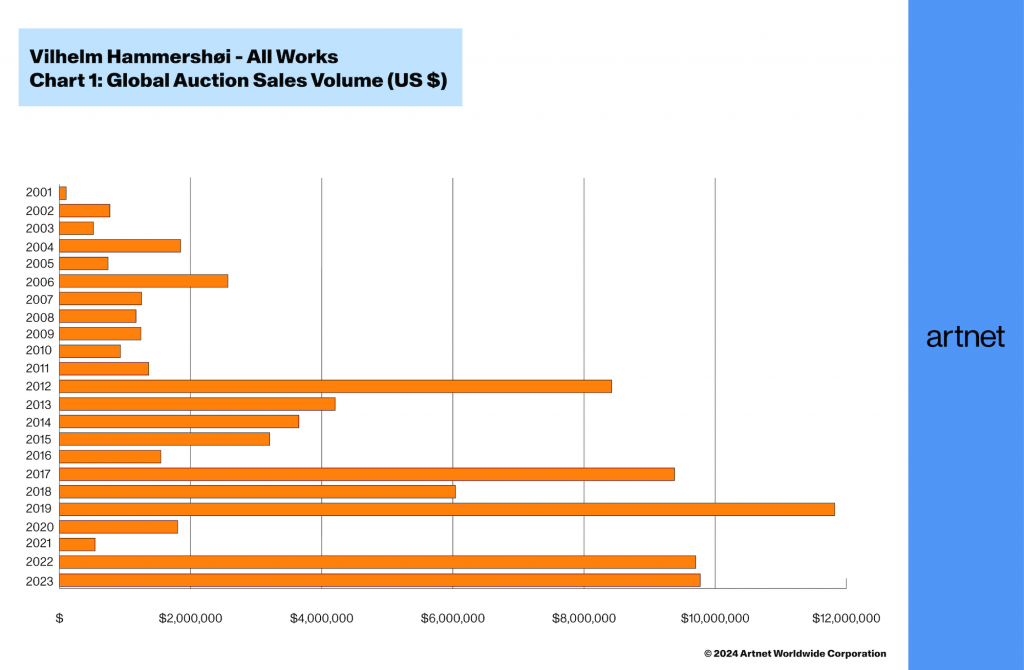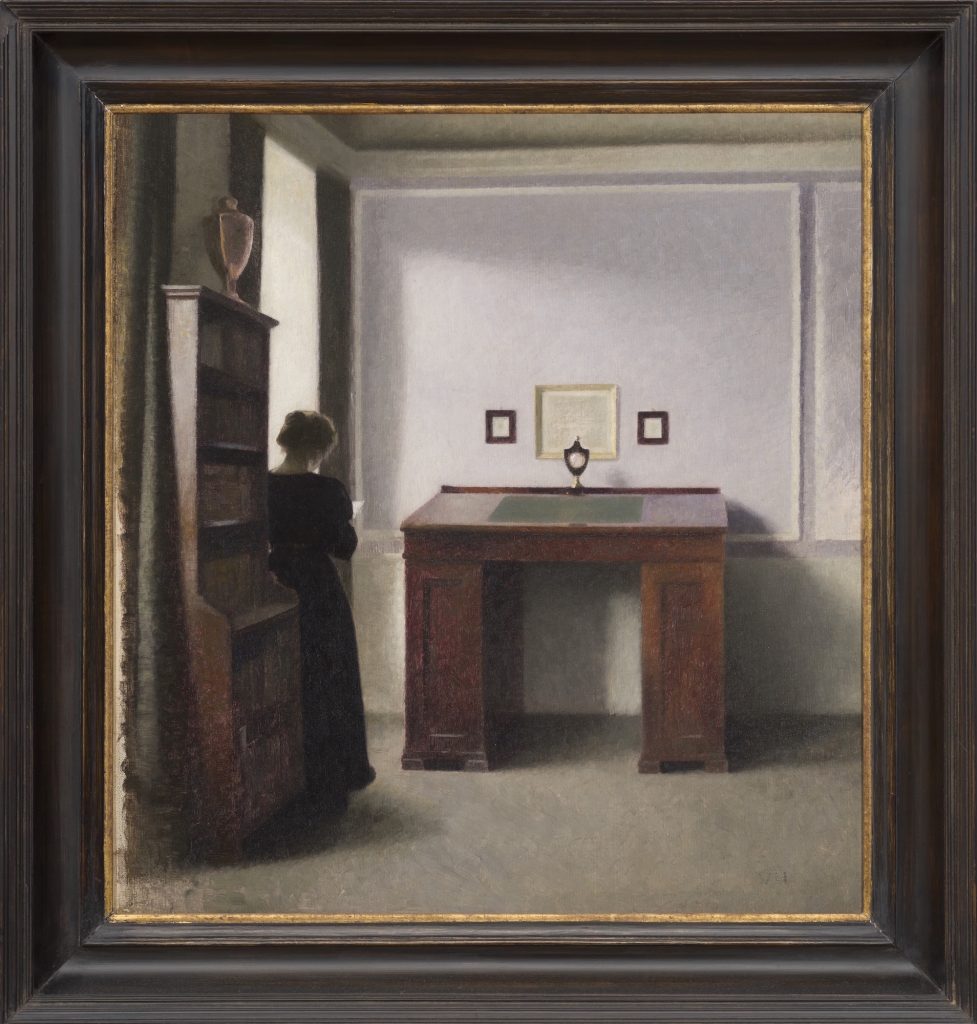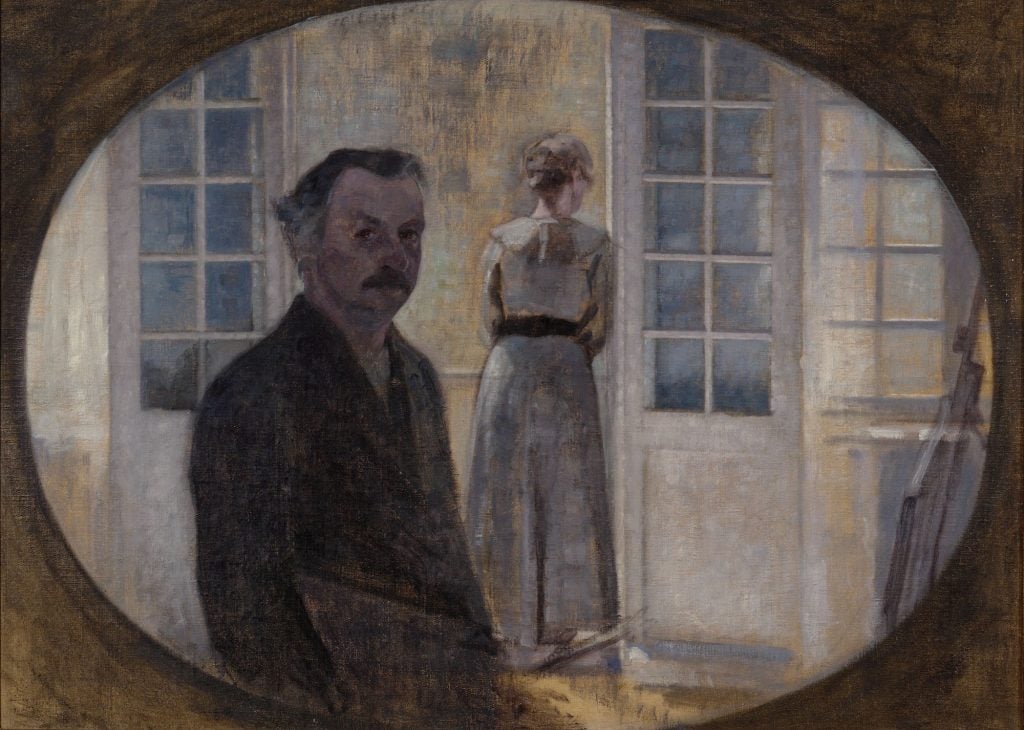The Appraisal
Vilhelm Hammershøi’s Cool Interiors Are Hot With Collectors. Thank Vermeer
A century after the Danish painter's death, prices for his work are rising.

A century after the Danish painter's death, prices for his work are rising.

Eileen Kinsella

The painter Vilhelm Hammershøi (1864–1916) has had a devoted and enthusiastic following for decades, but in recent years, his exposure and popularity—and his market—have reached new heights. Institutions, especially in North America, are clamoring for his quiet, intimate paintings of interiors, and scholars are studying his influence on successive generations of artists.
The artist’s works are undeniably reminiscent of those made in the 17th century by the Dutch master Johannes Vermeer, who had a record-breaking retrospective at the Rijksmuseum in Amsterdam last summer. Experts say that the fever for Vermeer (whose paintings are almost all in museums) has helped to boost Hammershøi (whose art remains available to collectors).
Hammershøi is having a moment. Phillips wrapped a selling exhibition in New York last month, “Stillness: Hammershøi and American Minimalism,” that included works collected by John Loeb Jr., an American businessman and former U.S. ambassador to Denmark who has been an ardent supporter of the artist. Curated by the auction house’s deputy chairman of Americas, Jeremiah Evarts, it placed the Dane’s work alongside pieces by contemporary figures like Agnes Martin and Robert Mangold.

Vilhelm Hammershøi, Interior with Windsor Chair (1913). Image courtesy Phillips.
Hammershøi’s “most common subject was the interiors of his own apartments,” Evarts said in an interview. “He painted two apartments repeatedly, which is why I connect it to American Minimalism with that sense of repetition and painting the same door, or window, or figure, which is his wife Ida, over and over again. It connects to what the minimalists do with their series.”

“Vilhelm Hammershøi: Silence” is on view at Hauser and Wirth in Basel, Switzerland, until July 13. Photo by Serge Hasenboehler
This past weekend, the powerhouse gallery Hauser and Wirth opened “Vilhelm Hammershøi: Silence” (June 1) at its new gallery in Basel, Switzerland, just in time for the opening of Art Basel next week. Set to run through July 13, it is the first solo show of the Danish painter in Switzerland.
“I think it’s very good to have this combination of the biggest art fair for contemporary and to have such a classical position here,” said Felix Krämer, who curated the show with the art historian and writer Florian Illies.
A Close Look at the Hammershøi Market

Source: Artnet Analytics ©Artnet Worldwide Corporation
Auction record: $9.1 million, for Interior. The Music Room, Strandgade 30 (1907), at Sotheby’s New York Modern evening sale, May 16, 2023, on an estimate of $3 million–$5 million.
Lots sold: 7
Bought in: 4
Sell-through rate: 63 percent
Total sales: $9.7 million
Top painting price: See above. The artist’s current record was set at this sale; the painting was acquired by the Art Institute of Chicago.
Lowest painting price: $108,000 (SEK 1.1 million) for Landskab, Vejle (1883), sold at Uppsala Auktionskammare in Sweden in last December.
Lowest overall price: $7,235 (50,000 DKK) hammer for a pencil on paper, Standing Naked Boy (circa 1884), sold at Bruun Rasmussen Auctioneers, in Lyngby, Denmark, outside Copenhagen, on December 6, 2023.
Expert View: What’s driving the demand for Hammershøi right now? Evarts, the Phillips deputy chairman, said that, not so long ago, the artist’s work was confined to sales focused on 19th-century European art. However, in 2017, when he was working at Sotheby’s, “I pulled in a work into an evening sale” for Impressionist and Modern art, he said. “I had a suspicion that there was an audience beyond the standard 19th-century painting collectors that would look at Hammershøi.”
His hunch was correct. At that 2017 sale, Interior with Woman at Piano, Strandgade 30 (1901) shattered its $3.5 million high estimate, selling for $6.2 million.
In Denmark, Hammershøi has been a revered figure for decades, but he is “not as well known outside of Scandinavia,” Evarts said. “In the last two years that has changed drastically.” Increasingly, Americans are entering the fold.
Museum interest has been key to building awareness. The Metropolitan Museum of Art acquired a work in 2012, and five other major institutions have followed suit, including the Art Institute of Chicago and the Getty. “I don’t know of another artist who has been so widely collected by North American museums in the last ten years,” Evarts said.

Vilhelm Hammershøi, Interior with a Writing Desk (1900). Image courtesy private collection.
As Evarts sees it, “There is a humanism that Hammershøi pulls out of Vermeer, and an intimacy that people really respond to.”
Krämer’s fascination with the artist dates back to 1995, when he was a student at Hamburg University in Germany. “No one really knew of Hammershøi,” he said. “I even had problems writing my master’s thesis on him because my professor at that time said, ‘Don’t go to the edges of art history.'” That thesis was on the interiors that the artist painted while living at Strandgade 30 in Copenhagen.
A survey at the Guggenheim Museum in New York in the late 1990s helped raise Hammershøi’s profile, though it had the misfortune of running during the controversial “Art of the Motorcycle” exhibition. Critic Hilton Kramer quipped that the motorcycles “drown out a nice show.”
The Hauser and Wirth exhibition brings together 16 works from private collections dating between 1883 and 1914, some of which have rarely been exhibited before. Nine of the works include a figure, and there is a rare self-portrait of the artist with his wife.

Vilhelm Hammershøi, Double Portrait of the Artist and His Wife, Seen through a Mirror.
The Cottage Spurveskjul (1911). Image courtesy private collection.
“There’s so much modernity in his works, and it’s so far away from an Old Master,” Krämer said, explaining that the artist took liberties with dimensions and played with perception. “The shadows don’t really fit,” he said. “The legs of the table are not the same length, or the perspective is off. Something awkward is going on and he does it deliberately.”
The Appraisal: According to the Artnet Price Database, roughly 20 Hammershøi works have sold at auction for more than $1 million each.
Until around 10 to 15 years ago, Evarts said, there was a curatorial emphasis on Hammershøi pieces up to about 1905, which are “tighter in execution” and more detailed than those he made after that. “What has changed in the last 10 years,” he said, “is greater and deeper appreciation from his later works, in which he uses more open brushwork.” Those examples “are increasingly abstract,” he said.
Krämer contrasted the artist’s approach with many of his 19th-century peers: “Hammershøi always stops before it gets to kitsch.” So, if Ida is arranging a vase with flowers, “you don’t see any flowers, only green,” he said. “Everything in Hammershøi is so reduced. There is a certain coolness to his works.”
The spacious, minimal feel of his rooms connects with the way that people live now. “Hammershøi is saying in his painting that there are not many objects, but you’ve got the feeling these objects are there for a reason,” Krämer said.